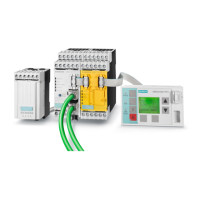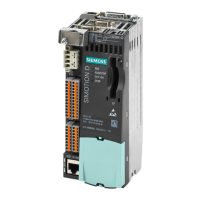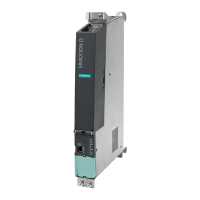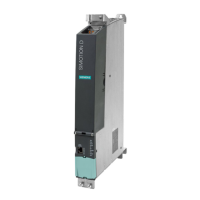Planning/Configuring
6.3 Device functions of the DM-F LOCAL
SIMOCODE pro - Fail-Safe Digital Modules
Manual, 11/2017, NEB631679702000/RS-AA/002
41
Device functions of the DM-F LOCAL
DIP switch settings, DM-F Local
Table 6- 2 Meaning of the DIP switches, DM-F Local
DIP
switch
Parameter Function
1 With / without cross-circuit
detection
Cross-circuit detection is only possible with floating sensors. The sensors must be
connected between T1 - Y12, Y33 and T2 - Y22, Y34. The device anticipates the
T1 terminal test signal at the terminals Y12 and Y33, and the T2 terminal test signal
at the terminals Y22 and Y34. The device detects a sensor fault if the signal at the
Y12, Y33 or the Y22, Y34 terminals is not identical to the test signals T1, T2.
Cross-circuit detection must be deactivated if electronic sensors such as light arrays
or laser scanners are connected. In this case, the DM-F Local no longer monitors the
sensor inputs for cross-circuits. Usually, the outputs of safety sensors (OSSD) are
already monitored for cross-circuits in the sensor itself.
If "Without cross-circuit detection" is set on the device, the test outputs T1, T2 are
deactivated and may no longer be connected. At the Y12, Y22, Y33, and Y34 inputs,
the DM-F Local expects a +24 V DC signal from the same current source as the one
from which the device receives its power supply (possible only in the case of DM-
F Local-*1AB00) or from T3 (static +24 V DC).
In the case of the DM-F Local -1AU00 device version, it is imperative to connect the
T3 terminal to the floating sensor contacts due to the electrical isolation between the
input circuit and the sensor power supply.
2 Evaluation:
1 NC + 1 NO evaluation /
2 NC evaluation
In addition to 2-channel connection of the same types of sensor contacts (NC / NC),
sensors with opposite types of contacts (NC / NO), as are frequently used for
electromagnetic switches, can also be evaluated. Make sure that the NC contact is
connected to Y12 and the NO contact to Y22.
3 Connection type:
2x 1-channel /
1x 2-channel
• 2 sensors with one contact each (2x 1-channel) (NC / NC). The two sensors are
"ANDed". Simultaneity is not monitored.
• 1 sensor with two contacts each (1x 2-channel) (NC / NC). The system expects
both contacts to be simultaneously open.
4 Debouncing time for
sensor inputs
50 ms / 10 ms
Any change in the sensor signal during the debouncing time is not evaluated.
• Debouncing time 50 ms: Switch position changes of strongly bouncing contacts
are suppressed (e.g. position switches on heavy protective doors).
• Debouncing time 10 ms: The shorter debouncing time permits faster deactivation
of bounce-free sensors (e.g. light arrays).
5 Start mode of sensor input
• Automatic start: The enabling circuits are switched to the active position as soon
as the starting condition at sensor inputs Y12, Y22, Y34 and terminal 1 have been
fulfilled. The start button connection terminal Y33 is not queried.
• Monitored start: The enabling circuits are switched to the active position as soon
as the switch-on condition is satisfied at the sensor inputs Y12, Y22, Y34, and at
terminal 1, and the start button at the Y33 terminal is actuated (start at falling
edge).
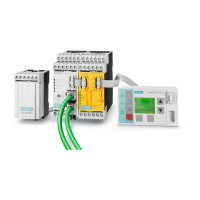
